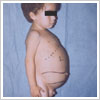Causes and Symptoms
All lysosomal storage disorders (LSDs) have a similar origin: a genetic (inherited) problem that causes a deficiency or malfunction of a particular enzyme in the body, so the enzyme cannot properly rid cells of waste material. Waste products accumulate in the lysosomes of cells, which leads to disruption of cell function. However, while all LSDs have a similar underlying cause, there is great variety among signs and symptoms of the individual diseases. As a group, the LSDs affect nearly every part of the body in people of all ages and races.
The types of bodily symptoms that arise in each disease vary depending on the type of waste material stored and the types of cells involved. For example, a LSD that affects cells in bone marrow and internal organs will cause very different symptoms from a disease that affects cells of the central nervous system. Some of the diseases can cause relatively mild symptoms that may not be apparent for some time, while others can be very severe and worsen rapidly.
 With LSDs, cells swell with accumulated waste With LSDs, cells swell with accumulated waste |
Importance of Early Diagnosis
Disease identification and diagnosis of these rare diseases can be challenging for several reasons:
- Outward symptoms of many LSDs often look like symptoms of other more common diseases, so pinpointing the actual cause can take some time.
- Some diseases may develop very slowly, so outward signs may be subtle and easily overlooked.
- Often even within a single disease, symptoms can vary from patient to patient, making it difficult to identify “typical” LSD symptoms.
LSD Red Flags
Despite the challenges of diagnosis, there are some signs and symptoms that occur frequently enough across several LSDs that they can be considered “red flags”--especially when several appear together:
- Unusual facial features (sometimes with enlarged tongue)
- Cloudy appearance to the eyes
- Purplish-blue skin rash
- Distended belly or protrusions from the abdomen (that could indicate enlarged organs or hernias)
- Short stature, failure to grow/develop properly, skeletal deformities
- Muscle weakness or lack of control, decline in motor skills or other development
|
|
Unusual facial features |
Be sure to discuss any such problems with a doctor, especially if they seem to be worsening over time. When there is suspicion of a LSD, the doctor can often order a test called an enzyme assay. It uses a sample (usually blood, urine, or skin tissue) to check the patient’s enzyme levels against levels considered normal. Very low activity for a particular enzyme generally confirms a conclusive diagnosis for the LSD associated with that enzyme.



 Distended belly from enlarged organs
Distended belly from enlarged organs